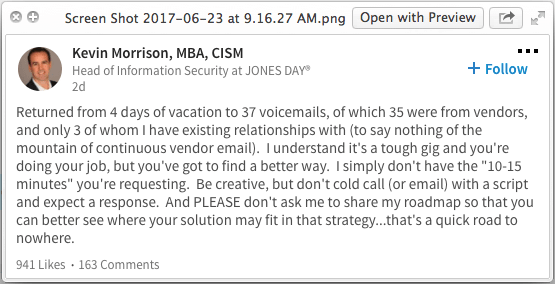C-Level Selling to Executives is a whole new ball game. You have to be pithy, respectful of their time, and you have to come up with ways to differentiate yourself from the competition in order to chop through the clutter and deserve the right to ask for something. In this blog, I give you some tips on selling to C-Level Executives.
Take a look at this example from a C-level buyer:

Outbound tactics without strategy are completely absurd. Hammering away in blended channels is worthless without leading with an insight-driven value narrative. It is not what we use, but how we use it.
Compared to selling to lower or mid-level employees, there is usually a multi-step process if they are not a person that makes the ultimate purchasing decision. By the time your pitch is run through the chain of command, your intended message will be dis-configured. If you can sell directly to C-level executives, and do it right, you will close sales much faster. The people who are making the decisions should be the ones to hear the facts straight from you.
So why are executive buyers so tough?
- They don’t buy into over the top ROI claims from sellers
- They’re senseless to all the outreach being projected at them
- They are under pressure, swamped in workload and they are time poor
- They filter requests based on referrals from a trusted source (peers they respect or people who work for them)
Hubspot gives examples of emails that secured meetings with CXO
5 how-to tips for selling to C-Level executives
1. Warm introduction
Getting a warm introduction from someone the C-Level Executive knows is a great advantage to accessing a C-Level Executive. Understand the nature of the relationship with the introduction and the executive will give some context on how they will receive your information.
2. Do your research
Always come prepared. I am stating the obvious, however, this is one of the most important tips in this blog. Looking for a conversation without doing your research is unprofessional and shows lack of respect.
Do not use information that is irrelevant to the region or business either. Find credible sources, and speak to others in the same market. Executives are very numbers driven, and place more value on proof.
3. Know what they want before they know they want it

At this point, you should be done with the basic questions and should already have valuable information about the company’s needs and background, as well as a firm grip on what you can bring to the table.
Occupied executives don’t have time to spoon-feed information or bide on details. If you understand their business goals and challenges they are much more likely to buy from you.
4. Strive to be a trusted adviser
Separate yourself in a way to captivate the organization by acting in their best interest rather than your own. Withstand the urge to push and close when they are not ready. Becoming a trusted adviser for a seller is attained over time and through the alignment with personal goals of the executive and the organization’s success. You should focus on the success of the customer rather than your own sales goal.
Being a trusted advisor is the first level out of 3 in the relationship with the C-level Executive.
Trusted Adviser — Collaboration and involvement in the planning process as well as trust with a personal connection.
Partner — Regarded as being strategic to the business and solicits your thoughts into the planning process.
Vendor — Transactions with exec and focusing on the primary way of defining greater value.
5. Be the CVO (Chief Value Officer)

When it comes to selling to C-Level Executives, time is money. A big complaint that most C-Level Executives talk about is the inability to get to the point. Remember you’re the Chief Value Revenue Officer in the room — from the perspective of both time and value. Sometimes you won’t have the luxury of setting up a PowerPoint or projector. When it comes to selling to C-Level Executives, you want your sales pitch to be compelling and concise.
A C-level executive will hardly ever object to a meeting being shorter than expected, but make sure you address a feasible solution that touches down on the challenges they are facing.
Also, keep this in mind. Reduce the overall negative impact of having a concise discussion about the value you will bring to the company.
Bonus tips
Use LinkedIn as a way to research the best path for a warm introduction instead of just using it as a spamming platform. Use information from the platform to drive relevant conversation around the responsibilities and needs that your prospect has.